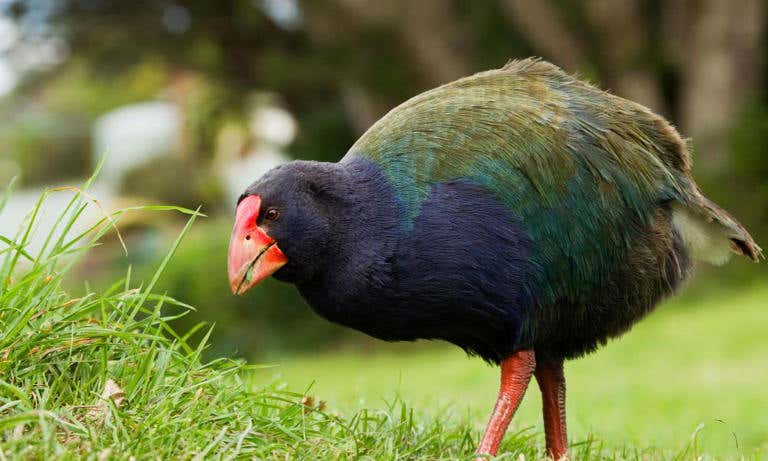Prehistoric bird thought to be extinct returns to the wild
New Zealand’s enigmatic flightless bird that was believed to have vanished from the face of the Earth – numbers are on the rise.

[Aug. 30, 2023: Staff Writer, The Brighter Side of News]
The takahe is a flightless bird indigenous to New Zealand and belonging to the rail family (CREDIT: Getty Images/iStockphoto)
In an unexpected twist to the tale of the takahe - New Zealand’s enigmatic flightless bird that was believed to have vanished from the face of the Earth - numbers are on the rise.
Against a backdrop of the modern-day struggles of conservation, this narrative brings a glimmer of hope and stands as a testament to the resilience of nature and the dedication of humankind.
Rediscovering the Lost Legend
Until 1948, the takahe, an awe-inspiring large flightless bird native to the lands of New Zealand, was considered a relic of a bygone era. Tales of its vibrant plumage and distinct gait were shared, but many believed it was forever lost.
It wasn't until its chance rediscovery in the remote regions of New Zealand that a light was ignited, prompting New Zealand's most ambitious and longest-running endangered species programme.
Related Stories:
A Flourishing Sanctuary: Zealandia
The Zealandia ecosanctuary, a refuge for many of New Zealand's precious avian species, recently welcomed a new pair of takahe, making waves in the global conservation community. These latest residents, a spirited three-year-old female named Waitaa, and a robust six-year-old male, Bendigo, have joined two of their peers already comfortably nestled in this haven.
For now, these young takahe ambassadors are residing in a carefully designed enclosure near the sanctuary's perimeter fence. This provides them with a brief hiatus, enabling them to adjust and familiarise themselves with their new surroundings. In just a few days, the gates will open, and they'll have the vast expanse of the sanctuary to explore.
Their journey to Zealandia was nothing short of extraordinary. Both birds were safely transported by plane from a Breeding Centre situated in the southern part of New Zealand. The meticulous planning and effort required to move these precious creatures further underscore their significance and the commitment to their preservation.
Waitaa and Bendigo arrived by plane from the a Breeding Centre in the south of New Zealand (CREDIT: Getty Images/iStockphoto)
The Takahe Lifecycle: A Closer Look
Despite their size and presence, takahe have a surprisingly delicate breeding pattern. They mate just once a year, typically raising a mere one or two chicks. Their lifespan varies depending on their habitat; in the wild, they tend to live between 16 to 18 years. However, under the protective watch of sanctuaries like Zealandia, their lives can extend to 20 to 22 years.
In 2021, the global count for this magnificent species stood distressingly low at only 440 individuals. To bolster their numbers and genetic diversity, conservationists move takahe around the country. This strategic relocation plays a pivotal role in ensuring the health and growth of the dwindling population.
The fight against extinction continues for New Zealand's takahe. (CREDIT: Getty Images/iStockphoto)
Historically, the vast terrains of New Zealand's South Island echoed with the calls of countless takahe. Their decline, however, began with a myriad of challenges they weren’t naturally equipped to face. The onslaught began with relentless hunting. As if that wasn’t enough, introduced predators, rampant habitat destruction, and fierce competition for food resources pushed the takahe to the brink of extinction.
Rebirth Through Resilience
Since their rediscovery, the story of the takahe has been nothing short of an epic journey. New Zealand’s initiative spanning over seven decades has employed innovative conservation techniques tailored specifically for endangered species. A multipronged approach was adopted which ranged from captive breeding, meticulous island translocations to controlled wild releases.
The takahe have a cultural significance to Maori and have appeared in a stamp. (CREDIT: Getty Images/iStockphoto)
“The takahe is more than just a bird; it's a symbol of hope, of the unwavering spirit of conservationists and the undying will of nature,” says a local conservationist. “Every chick born, every bird released into the wild, is a testament to the relentless efforts to ensure that takahē are never again merely footnotes in history books.”
The story of the takahe is a poignant reminder of the intricate balance of our ecosystem. Their resurgence from the precipice of extinction showcases the incredible results that can be achieved when dedication, science, and passion converge. As Waitaa and Bendigo settle into their new home at Zealandia, they carry with them the hopes and dreams of a nation and serve as beacons for global conservation efforts.
Note: Materials provided above by The Brighter Side of News. Content may be edited for style and length.
Like these kind of feel good stories? Get the Brighter Side of News' newsletter.
Joseph Shavit
Head Science News Writer | Communicating Innovation & Discovery
Based in Los Angeles, Joseph Shavit is an accomplished science journalist, head science news writer and co-founder at The Brighter Side of News, where he translates cutting-edge discoveries into compelling stories for a broad audience. With a strong background spanning science, business, product management, media leadership, and entrepreneurship, Joseph brings a unique perspective to science communication. His expertise allows him to uncover the intersection of technological advancements and market potential, shedding light on how groundbreaking research evolves into transformative products and industries.



